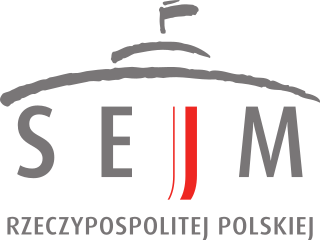
Sigismund II Augustus was the King of Poland and Grand Duke of Lithuania, the only son of Sigismund I the Old, whom Sigismund II succeeded in 1548.
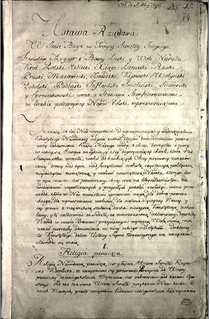
The Constitution of 3 May 1791 was a constitution adopted by the "Great Sejm" for the Polish–Lithuanian Commonwealth, a dual monarchy comprising the Crown of the Kingdom of Poland and the Grand Duchy of Lithuania. The Constitution was designed to correct the Commonwealth's political flaws and had been preceded by a period of agitation for—and gradual introduction of—reforms, beginning with the Convocation Sejm of 1764 and the consequent election that year of Stanisław August Poniatowski as the Commonwealth's last king.

The Council of State of the Republic of Poland was introduced by the Small Constitution of 1947. It was preceded by the State National Council created in 1943 by Gomułka. The Council of State consisted of the President of the Republic of Poland, the Marshal and Vice-marshals of the Sejm, President of the Supreme Chamber of Control and other members. The Council of State had the power to approve decrees issued by the Council of Ministers of the Sejm, exercise the supreme control over the local national councils, approve promulgation of laws concerning the budget and military draft, declare a state of emergency and martial law, originate bills and others.
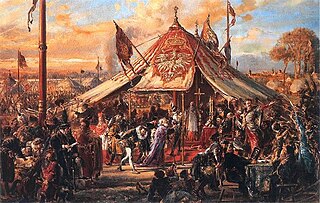
Royal elections in Poland was the election of individual kings, rather than of dynasties, to the Polish throne. Based on traditions dating to the very beginning of the Polish statehood, strengthened during the Piast and Jagiellon dynasties, they reached their final form in the period of the Polish-Lithuanian Commonwealth between 1572 and 1791. The "free election" was abolished by the Constitution of 3 May 1791, which established a constitutional monarchy.

Count Franciszek Maksymilian Ossoliński was a Polish nobleman, politician, diplomat and a patron of arts.

Stanisław Michał Ernest Denhoff was a Polish–Lithuanian Commonwealth aristocrat, Grand Master of the Hunt of Lithuania, Grand Chorąży of the Crown (1704–1721), voivode of Połock (1721–1728), politician and a military commander.
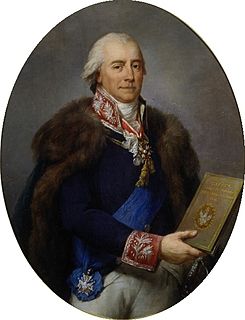
Count Tomasz Adam Ostrowski was a Polish nobleman (szlachcic), politician, spokesman, statesman and Count since 1798.

The Familia was the name of an 18th-century Polish political party led by the House of Czartoryski and allied families. It was formed towards the end of the reign of King of Poland Augustus II the Strong. The Familia's principal leaders were Michał Fryderyk Czartoryski, Grand Chancellor of Lithuania, his brother August Aleksander Czartoryski, Voivode of Ruthenia (Rus), their sister Konstancja Czartoryska,and their brother-in-law, Stanisław Poniatowski, Castellan of Kraków.
Silent Sejm is the name given to the session of the Sejm (parliament) of the Polish-Lithuanian Commonwealth of 1 February 1717 held in Warsaw. A civil war in the Commonwealth was used by the Russian Tsar Peter the Great as an opportunity to intervene as a mediator. It marked the end of Augustus II of Poland's attempts to create an absolute monarchy in Poland, and the beginning of the Russian Empire's increasing influence and control over the Commonwealth.

The Permanent Council was the highest administrative authority in the Polish–Lithuanian Commonwealth between 1775 and 1789 and the first modern executive government in Europe. As is still typically the case in contemporary parliamentary politics, the members of the Council were selected from the parliament or Sejm of the Commonwealth. Even though it exerted some constructive influence in Polish politics and government, because of its unpopularity during the Partitions period, in some Polish texts it was dubbed as Zdrada Nieustająca - Permanent Betrayal.

The Constitution of the Polish People's Republic was passed on 22 July 1952. Created by the Polish communists in the Polish People's Republic, it was based on the 1936 Soviet Constitution, and it superseded the post-war provisional Small Constitution of 1947 which, in its turn, had declared null and void the pre-war April Constitution of Poland passed by the Polish Sejm in 1935. The Russian text of the Constitution was reviewed and 'corrected' by Joseph Stalin himself, and later translated into Polish. It legalized the communist legislature and practices as they had been introduced to Poland with the Polish Committee of National Liberation in the wake of Red Army progress in 1944.

Grodno Sejm was the last Sejm of the Polish–Lithuanian Commonwealth. The Grodno Sejm, held in fall of 1793 in Grodno, Grand Duchy of Lithuania is infamous because its deputies, bribed or coerced by the Russian Empire, passed the act of Second Partition of Poland. The Sejm started on 17 June and ended on 23 November 1793. It ratified the division of the country in a futile attempt to prevent its subsequent complete annexation two years later in the 1795 Third Partition of Poland.
The Tarnogród Confederation was a confederation of szlachta in Polish-Lithuanian Commonwealth, in the years 1715–1716. It was formed on 26 November 1715 in Tarnogród by nobility angered by illegal taxation, levied for Saxon forces operating in Grand Duchy of Lithuania on behalf of Augustus II the Strong, who wanted to introduce absolute monarchy in the Commonwealth. Its marshal was Stanisław Ledóchowski. The confederates and the royal forces did not fight any decisive battles, but they fought numerous smaller skirmishes; several towns and castles were taken. The ensuing negotiations eventually brought Peter I of Russia and Russian Empire forces into the Commonwealth "for peacekeeping and mediation". This event marked the beginning of lasting Russian Empire influence on Commonwealth internal affairs, starting with the Silent Sejm of 1717.

The early modern era of Polish history follows the late Middle Ages. Historians use the term early modern to refer to the period beginning in approximately 1500 AD and lasting until around 1800.

The Union of Lublin was signed on 1 July 1569, in Lublin, Poland, and created a single state, the Polish–Lithuanian Commonwealth. It replaced the personal union of the Crown of the Kingdom of Poland and the Grand Duchy of Lithuania with a real union and an elective monarchy, since Sigismund II Augustus, the last of the Jagiellons, remained childless after three marriages. In addition, the autonomy of Royal Prussia was largely abandoned. The Duchy of Livonia, tied to Lithuania in real union since the Union of Grodno (1566), became a Polish–Lithuanian condominium.
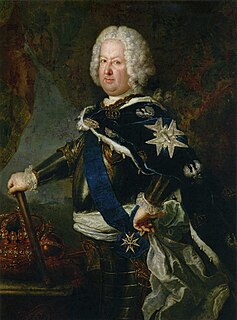
On February 1, 1733, the King of Poland and Grand Duke of Lithuania Augustus II the Strong died in Warsaw, leaving the Polish-Lithuanian Commonwealth without a monarch. Another royal election was necessary. This time, the Polish - Lithuanian nobility firmly opposed a foreign candidate, such as Portuguese Duke Infante Manuel, Count of Ourem, who was supported by the Russian Empire and the Habsburg Empire.

The Seven Years' War, which ended in 1763, established a new pattern of political alliances in Europe. The Kingdom of Prussia, the Kingdom of Great Britain and the Russian Empire emerged as great powers, while the position of Austria, France, Spain, Sweden and the Ottoman Empire was weakened. As a result of the war, the Russian Empress, Catherine the Great, was in almost complete control of the Polish–Lithuanian Commonwealth. Catherine was supported by the Prussian monarch, Frederick the Great, who hoped to eventually annex Polish provinces of Royal Prussia and Greater Poland.
